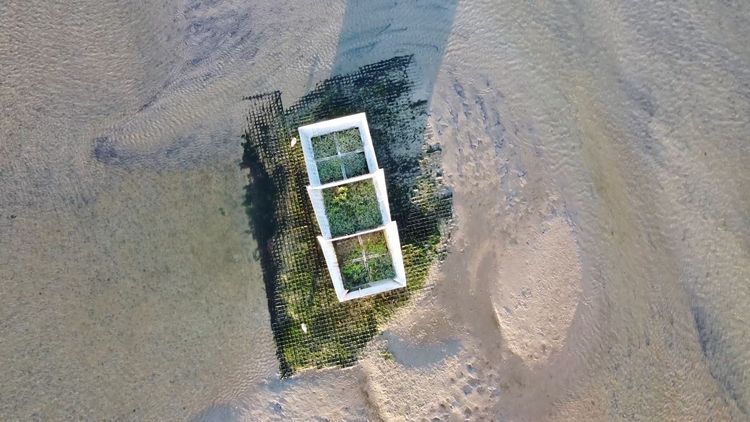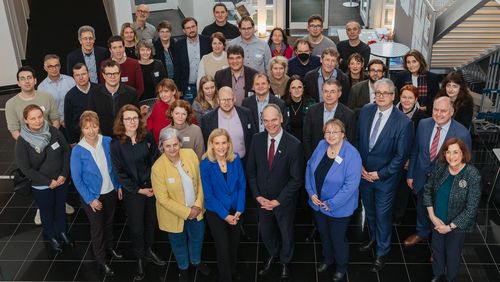The research group DynaCom is investigating how stable ecosystems are in the face of natural and anthropogenic environmental changes. The German research Foundation is now funding the project for another three years.
Ecosystems have a wide variety of functions – for example, they store carbon, produce oxygen or filter water. But what determines the functional stability of an ecosystem? One central aspect is the degree to which the composition of species can adapt or recover, for example in response to environmental change. This is one of the findings of the research group DynaCom, which has been funded by the German Research Foundation (DFG) since early 2019. The project focuses on food webs and biodiversity in landscapes that are constantly changing.
Following unanimous positive reviews, the DFG is now funding the project for another three years with around three million euros. "We are very pleased about this success, which rewards the great cooperation of the past years," says the spokesperson and biodiversity expert Prof. Dr Helmut Hillebrand of the university’s Institute for Chemistry and Biology of the Marine Environment (ICBM). "In our research, we specifically link ecological modelling with observation and experiments to better understand how communities form and to predict their development."
Exploring the limits of predictability
The DynaCom research group is grounded in one of the most studied ecological concepts, the theory of island biogeography. It helps researchers analyse the role that the dynamic balance between species immigration and extinction plays in the total number of species on an island ecosystem. "But the theory doesn't predict which species will settle or the characteristics of successful species," Hillebrand explains. DynaCom thus extends the theory of island biogeography to include the following questions: Which species establish themselves on islands? And how do successful species differ from other species?
To address these questions, the research team is exploring the limits of predictability by focusing on the highly dynamic food webs of marine and terrestrial species communities in the Wadden Sea. "Here, there are strong rhythmic but also random changes in environmental conditions," explains Oldenburg landscape ecologist Prof. Dr Michael Kleyer, who is also involved in the project. Moreover, the boundaries between terrestrial and marine communities are blurred, he points out. "This allows us to analyse the different parts of food webs and their interactions in a comprehensive way."
Which organisms will become established?
The studies focus on the species’ traits, that is the biological characteristics that enable species to occur, spread and survive in different habitats. These include, for example, the ability of plants to take up certain nutrients such as nitrogen. The research group is investigating whether these traits can be used to predict which organisms will become established in a community.
"Not only does this approach provide us with a fundamental understanding of how communities develop, but also with information about how to apply our knowledge”, Hillebrand explains. For example, he says, the results of experiments and ecological modelling can be used to deduce which measures might be useful for restoring ecosystems in such a way that the desired species can establish themselves. The research group conducts the corresponding experiments primarily on the artificial islands constructed in 2014 in the tidal flats off the island Spiekeroog in the East Frisian Wadden Sea. Control experiments take place in the salt marshes of Spiekeroog.
Successful research despite pandemic conditions
In the first phase of the project, the researchers described the components of the food web from protozoa to birds based on traits. This allowed the team to understand how much resources different organisms invest in their dispersal, interaction with other species or tolerance to environmental conditions. "It cannot be praised enough how much the team, especially the PhD students and postdocs, have pushed the experiments, field investigations and modelling under pandemic conditions," Hillebrand points out.
In the upcoming second funding phase, the researchers are now using their previous results as a basis to test how rapidly changing environmental conditions and disturbances such as storms affect the composition of traits in species communities. The project thus makes a central contribution to the overarching question of how stable ecosystems are in the face of natural and anthropogenic changes, Hillebrand explains. After all, ecosystem functioning relies on the ability of organisms to tolerate change or recover rapidly afterwards. The research team has already paved the way to the new funding phase with initial fundamental work.
In addition to working groups from the ICBM and the University's Institute of Biology and Environmental Sciences, researchers from the University of Göttingen, the German Centre for Integrative Biodiversity Research (iDiv) Halle-Jena-Leipzig, the Museum König Bonn, the Technical University of Munich, as well as the Senckenberg Gesellschaft für Naturforschung Wilhelmshaven/Frankfurt and the Geomar – Helmholtz Centre for Ocean Research Kiel are involved.




